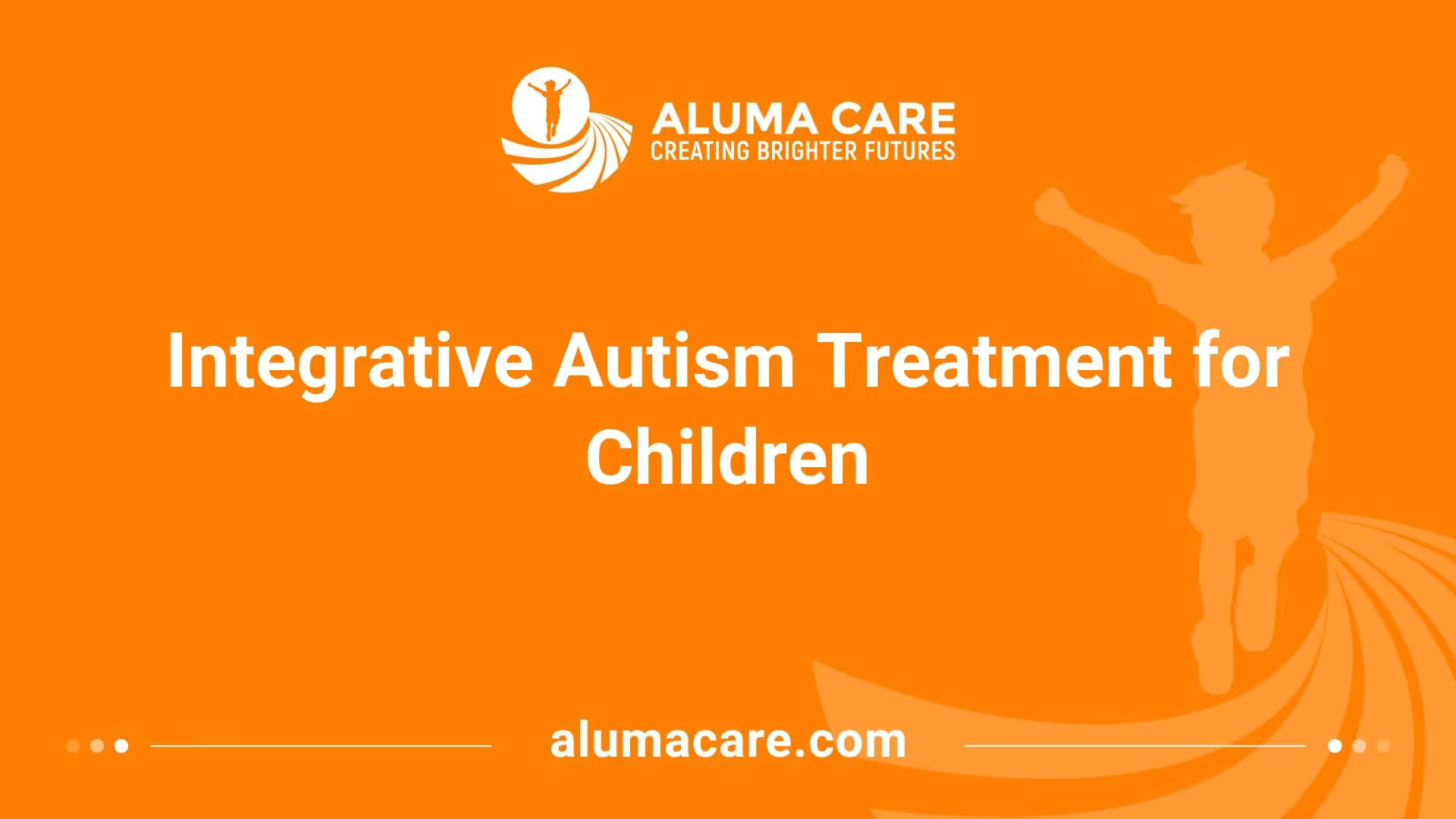
Available Autism Treatments
Autism treatment for children encompasses a range of therapies designed to improve communication, social skills, and manage associated behaviors. Among the most recognized are Applied Behavioral Analysis (ABA) therapy and Cognitive Behavioral Therapy (CBT).
Gold Standard: ABA Therapy
ABA therapy is regarded as the gold standard in autism treatment, addressing various skills from communication and socialization to reducing challenging behaviors. It employs data-driven methods to teach new skills and diminish problem behaviors, making it highly individualized. According to Empower Behavioral Health, behavioral approaches, particularly ABA, have substantial evidence supporting their efficacy in treating symptoms of Autism Spectrum Disorder (ASD), receiving wide acceptance among educators and healthcare professionals.
Two primary styles of ABA include:
Teaching StyleDescriptionDiscrete Trial Training (DTT)Breaks down skills into smaller, teachable components with clear instructions and feedback.Pivotal Response Training (PRT)Focuses on enhancing pivotal areas of a child's development, such as motivation and self-management.
Progress in ABA therapy is meticulously tracked and measured, ensuring effective interventions are applied. This intensive, one-on-one therapy is particularly beneficial for young children with ASD, teaching them language, social, and other skills through short tasks, positive reinforcement, and gradual autonomy.
The most effective interventions combine specialized and supportive educational programming, communication training, social skills support, and behavioral interventions. Complementary therapies like occupational therapy and physical therapy can also enhance developmental progress, particularly for children facing additional challenges such as motor coordination and sensory deficits.
CBT Approach
Cognitive Behavioral Therapy (CBT) provides significant benefits for individuals with autism experiencing anxiety, obsessive behaviors, or depression. This approach equips them with practical tools to manage their emotions, reduce anxiety, and develop coping strategies. CBT focuses on teaching emotional regulation and fostering improved behavior through structured methods.
Psychological approaches like CBT can help individuals with ASD better cope with anxiety, depression, and other mental health challenges. The therapy emphasizes the interplay between thoughts, feelings, and behaviors, promoting positive changes in reactions to various situations [4].
Through the application of evidence-based therapies like ABA and CBT, caregivers can make informed decisions about the best treatment strategies tailored to their child's specific needs. For further information on therapy evaluation, please refer to our autism treatment evaluation checklist.
Holistic Therapies

Holistic therapies offer a comprehensive approach to autism treatment for children. These therapies aim to address various aspects of an individual's development, focusing not only on their behavior but also on their overall well-being.
Occupational Therapy Benefits
Occupational therapy plays a crucial role for individuals with autism, especially for those facing challenges related to sensory processing, fine motor skills, and daily living activities. Occupational therapists design tailored interventions that enhance a child's independence and improve their overall quality of life.
The benefits of occupational therapy for children with autism can be summarized as follows:
BenefitDescriptionSensory Processing SupportHelps children manage sensory input, reducing overwhelm or discomfort.Motor Skill DevelopmentImproves fine and gross motor skills necessary for everyday tasks.Daily Living SkillsTeaches self-care and daily living activities to promote independence.Enhanced Quality of LifeIncreases confidence and ability to participate in everyday activities.
Personalized interventions can make a significant difference for children facing difficulties in these areas [3].
Personalized Treatment Plans
Creating personalized treatment plans is essential for effective autism treatment. Each plan should be customized to meet the unique needs of the individual child. For example, a child struggling with language development, motor skills, and daily functioning may have a treatment plan that includes various therapies such as speech, physical, and occupational therapy [3].
Key components of a personalized treatment plan may include:
ComponentDescriptionSpeech TherapyFocuses on enhancing communication skills.Physical TherapyAims to improve motor skills and physical fitness.Occupational TherapyAddresses practical daily skills and sensory processing.Family InvolvementEngages family members in the treatment process to ensure supportive home environments.
Personalized treatment plans not only address the specific challenges a child may face but also enhance their overall development and potential [1]. Tailoring these plans requires close collaboration among healthcare providers and families, creating a comprehensive support network for the child.
Therapy Selection Process

Selecting the appropriate therapy for autism involves several key steps. The process begins with an initial assessment, which is essential for understanding the child's unique needs and strengths.
Initial Assessment Importance
An initial assessment is a critical step in the therapy selection process for autism treatment. This assessment involves a thorough evaluation of the child's abilities, challenges, and specific goals. By identifying these factors, caregivers can ensure that the chosen therapy aligns with the child's individual needs, promoting successful outcomes. It is recognized that personalized treatment plans are vital; for example, a child facing difficulties with language development might require a combination of speech therapy, physical therapy, and occupational therapy [3].
Assessment ComponentsPurposeCognitive AssessmentUnderstand cognitive strengths and challengesSocial Skills EvaluationIdentify social interaction abilities and difficultiesBehavioral AnalysisDetermine behavioral concerns that need addressingCommunication AssessmentEvaluate language skills and communication needs
Family Participation
Family involvement in the therapy process plays a significant role in determining its effectiveness. Collaboration among therapy providers, educators, and family members creates a supportive environment that facilitates progress for the child with autism. Family members offer insights about the child's behavior in various settings, which can help tailor the therapy to meet their needs effectively.
Building a strong family autism care team fosters consistent communication and reinforcement of skills learned during therapy. Active participation also helps empower families, allowing them to support their child's development positively and reinforcing skills gained during therapy sessions.
In conclusion, the importance of a comprehensive initial assessment and active family participation cannot be overstated. These elements significantly enhance the likelihood of successful interventions and overall autism treatment for children.
Dietary Interventions
Dietary interventions are increasingly recognized as a valuable component of autism treatment for children. These approaches focus on providing a balanced and nutritious diet tailored to meet the specific needs of individuals with Autism Spectrum Disorder (ASD).
Impact of Nutrition on ASD
Research indicates that dietary components can have a significant impact on the symptoms and behaviors associated with ASD. Nutritional interventions aim to improve overall well-being by addressing potential deficiencies and optimizing nutrient intake. Some key areas of focus include reducing inflammation, improving behavioral symptoms, and enhancing gut health. Specific nutrients like antioxidants, polyphenols, probiotics, prebiotics, and vitamin D have shown promise in studies.Golden Care Therapy.
Nutritional ComponentPotential BenefitsAntioxidantsMay help reduce oxidative stressPolyphenolsCould improve behavioral symptomsProbioticsSupports gut health and may improve behavioral and gastrointestinal symptomsVitamin DPotentially enhances behavioral symptoms and neuroprotectionCamel MilkMay reduce inflammation and oxidative stress
Dietary Components and Benefits
Exploring dietary interventions can form an essential part of a comprehensive autism treatment strategy. Families may consult with healthcare providers or nutrition specialists to create personalized plans that account for individual preferences and requirements. This collaborative approach can enhance the effectiveness of autism treatment, ensuring a holistic strategy for managing ASD symptoms. For further support, families can involve a family autism care team.
Medications and Psychological Approaches
In addressing autism treatment for children, it is essential to explore both medication options for co-occurring symptoms and psychological therapies tailored for individuals on the autism spectrum.
Medications for Co-Occurring Symptoms
Medications are often utilized to manage a variety of co-occurring symptoms and conditions found in children with autism spectrum disorder (ASD). These may include issues like high energy levels, focus difficulties, self-harming behaviors, anxiety, depression, seizures, and sleep disorders. Collaborating with a medical professional experienced in treating individuals with ASD is crucial for effective monitoring and adjustment of medication [4].
The following table summarizes the FDA-approved medications for children with ASD, along with their intended uses:
MedicationAge RangeApproved UseRisperidone (Risperdal)5-16Treatment of irritabilityAripiprazole (Abilify)5-16Treatment of irritability
Although these medications can help alleviate certain symptoms, it is important to note that no current medications are established for the core symptoms of ASD. Many clinicians may prescribe off-label medications to address specific behaviors, which can sometimes come with significant side effects. Research suggests that up to 47% of youth with ASD are prescribed psychotropic medications [6].
Psychological Therapies for ASD
Psychological therapies play a vital role in the overall treatment plan for children with autism. Among these, cognitive behavioral therapy (CBT) has been identified as the most effective method for addressing emotional challenges, including anxiety and depression, in individuals with ASD. This approach helps individuals understand the connections between their thoughts, feelings, and behaviors, facilitating positive changes in their reactions to various situations [4].
Despite its effectiveness, the application of CBT is often limited due to a shortage of trained experts in the field. Nonetheless, its core principles can be beneficial for many children with ASD, promoting improved coping strategies and emotional support.
Additionally, naturalistic developmental behavioral interventions have demonstrated effectiveness in improving language, cognitive function, and social skills among children with ASD. However, further research is needed to validate some of these findings fully, especially concerning their impact on communication and social initiation [7].
By combining appropriate medication for co-occurring symptoms with targeted psychological therapies, a comprehensive support plan can be established to address the individual needs of children with autism, enhancing their overall quality of life.
Early Intervention Strategies
Importance of Early Diagnosis
Early diagnosis plays a crucial role in the development and treatment of children with autism spectrum disorder (ASD). Recent guidelines suggest that starting an integrated developmental and behavioral intervention as soon as ASD is diagnosed or seriously suspected is vital. The sooner a child receives help, the greater the chance for learning and progress [8].
Research has shown that early intervention can lead to improved outcomes in various areas, including communication, socialization, and behavior. Children who undergo early interventions can experience a significant enhancement in their IQ, with average gains reported to be around 17 points. Moreover, these children are more likely to attend regular education classes, achieve higher rates of employment in adulthood, and require fewer support services later in life [9].
Effective Early Intervention Programs
Effective early intervention programs are designed to address the specific needs of children with ASD and can vary widely. Here are some common approaches included in early intervention strategies:
Intervention TypeDescriptionApplied Behavior Analysis (ABA)A structured, evidence-based approach that uses reinforcement techniques to improve behavior and teach new skills.Developmental, Individual Differences, Relationship-Based Model (DIR/Floortime)Focuses on emotional and relational development, encouraging play and interaction.Early Start Denver Model (ESDM)A comprehensive intervention that integrates ABA principles into naturalistic settings for younger children.Social Skills TrainingHelps children with ASD develop social skills through targeted practice and group interaction.Parent-Mediated InterventionsEducates parents on how to support their child's development through daily interactions.
Early interventions not only provide these children with the best start possible, but they also set the groundwork for long-term success. As parents consider options for autism treatment for children, they are encouraged to research various programs and find the most suitable ones for their children’s unique needs.
The impact of interventions is significantly enhanced when families participate in the process. Engaging parents in their child’s treatment not only fosters a supportive home environment but also encourages skill reinforcement outside of therapy sessions. This holistic family involvement is essential in creating effective gender-inclusive autism services that facilitate the child's growth.
References
[2]:
[3]:
[4]:
[5]:
[6]:
[7]:
[8]:
[9]:








.svg)

.svg)
.svg)